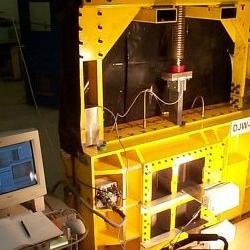A number of current projects involve model testing at 1-g, rather than on the centrifuge. Three large plane-strain chambers are used to examine deformations around penetrometers, and pollution flow and remediation processes. Work is underway to optimise the design and operation of screw conveyers and soil-mixing augers through small-scale models.
A stiff plane-strain calibration chamber featuring a reinforced window allows soil flow around an advancing penetrometer to be captured using digital imaging. The resulting images are processed using in-house image analysis software to deduce precise strain paths. The stiff reinforced design allows direct observation of deforming soil at stresses of up to 30 MPa.
Another plane-strain chamber is being used to investigate air sparging. This chamber allows the investigation of air sparging mechanisms in a heterogeneous distribution of NAPL ganglia/pools. The potential for air sparging to change the permeability of the flow field is being examined. If a preferential flow path develops, zones of NAPL can remain trapped. The objective of the current research is to evaluate the removal efficiency for a pure NAPL pool entrapped in different conditions. Future tests will address the effect of rate limited mass transfer from NAPL phase to vapour phase.
The screw conveyor in an earth pressure balance tunnelling machine is critical to the control of the excavation process. A 1:5 scale model screw conveyor system is being constructed for experiments to investigate the operation in different soils and the effects of soil conditioning agents on the performance. Instruments allow measurement of the normal and shear stresses and the pore pressures along the conveyor during operation.
Finally, small scale soil augers are being used to simulate deep mixing techniques. The load capacity of soil-mixed columns with and without waste materials is being investigated and compared with the load capacity of standard bored piles.


